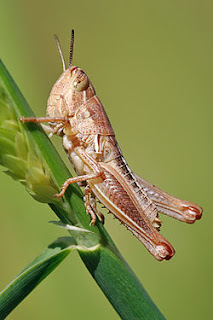As with anything I run into that is of interest I look for as much information on it as I can. Today's interest? Grasshoppers. I figure the more I know about these guys the better, "keep your friends close and your enemies closer", right? Well they pose as enemies to my garden which makes them an enemy to me as well, after all, I do want to taste the lettuce, basil and bush beans at some point.
The physical structure of the grasshopper consists of antennae which are generally shorter in length than their bodies (opposed to roaches, which is the first insect I think about when thinking about insects with long antennae- ick!) The female grasshopper is larger than the male grasshopper and can be distinguished from the males in many ways, one way is that the female grasshopper have two pairs of triangles at the end of their abdomen opposed to one single plate that the male has, the two pairs of triangles appropriately known as valves are used for laying eggs in the sand. The valves are used to dig into the sand where the female grasshopper will lay her eggs.
The grasshopper also have tiny hairs all over the exterior of the body with the main purpose of acting as sensors. These little hairs are specially calibrated to respond to certain stimulus. However the portion of the grasshopper that is the most sensitive to sensing are the antennae, part of the mouth and near the posterior. Grasshoppers also have tympanal organs for sound reception.
Grasshoppers are easily confused with crickets, but are different in many aspects.
This is a cricket
The grasshopper diet consists mainly of grasses, leaves and cereal crops (as in grains). Many grasshoppers eat a variety of plants making them polyphagous, and many tend to eat from multiple sources in one day (in my experience they jump from basil to bush bean). Some grasshoppers however do feast on the same, one plant (monophagous), the monophagous grasshoppers are far fewer (about one out of 8,000).
The digestive system of a grasshopper consists of a foregut, midgut and a hindgut...
The function of the foregut (the mouth region): the mouth is distinct due to the presence of a mandible and salivary glands. It is the mandibles job to begin the mechanical portion of the digestion by chewing, but only very slightly.
The function of the midgut: is where most of the food is handled in the crop which has the ability to hold food. The crop leads the food into the gizzard consisting of teeth like features. From the gizzard the food enters the stomach where digestive enzymes help to break down particles.
The function of the hindgut (the anal region): the hindgut, similar to human anatomy, is the portion of the digestive system that is focused on excreting the waste, which consists of uric acid, urea and amino acids, and are normally converted into dry pellets before being disposed.
SUGGESTED METHOD FOR TERMINATION:
Dusting host plants lightly with baking flour
*Read the full article on Wikipedia, Grasshopper





No comments:
Post a Comment